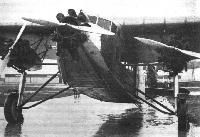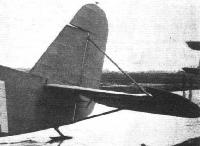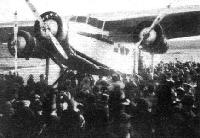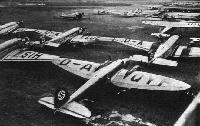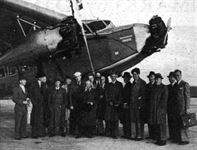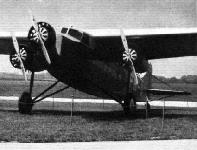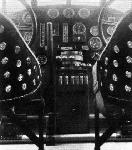
Описание
Страна : Нидерланды
Год : 1929
Транспортный самолет с экипажем из двух/трех человек
Fokker F.IX и F.39
Высокоплан F.IX внешне напоминал увеличенный F.VIII-3m и был оснащен тремя моторами Jupiter. Самолет предназначался для перевозки 18 пассажиров на европейских авиалиниях; от четырех до шести пассажиров размещались в салоне повышенного комфорта, а на линиях между Голландией и Голландской Ост-Индией в самолетах оборудовались спальные места. Первый F.IX поднялся в воздух 26 августа 1929 года, его эксплуатация в авиакомпании KLM началась 8 мая 1930 года; самолет назвали "Adelaar" (орел). Второй F.IX доработали, удлинив носовую часть фюзеляжа для размещения 20 пассажиров, машина была показана на авиасалоне в Париже в 1930 году, а в январе 1931 года ее передали KLM.
Хотя первый F.IX и выполнил несколько полетов на Дальний Восток, обычно он эксплуатировался в варианте на 17 пассажиров между Амстердамом и Лондоном. После установки новых моторов самолет в октябре 1936 года продали французской компании "Air Tropic", а потом - Испанской республике. После окончания гражданской войны в Испании самолет достался франкистам.
Два F.IX построила по лицензии в Чехословакии фирма "Avia", эти самолеты эксплуатировала авиакомпания СБА под обозначением F.39 с двигателями Walter Pegasus мощностью 635 л. с. "Avia" спроектировала также военный вариант - 12 бомбардировщиков F.IXM поступили на вооружение ВВС Чехословакии, а два под обозначением F.39 поступили в ВВС Югославии.
ТАКТИКО-ТЕХНИЧЕСКИЕ ХАРАКТЕРИСТИКИ
Fokker F.IX (исходный вариант)
Тип: транспортный самолет с экипажем из двух/трех человек
Силовая установка: три звездообразных мотора Gnome-Rhone (Bristol) Jupiter VI мощностью по 500 л. с.
Летные характеристики: максимальная скорость на оптимальной высоте 212 км/ч; крейсерская скорость на оптимальной высоте 175 км/ч; практический потолок 3600 м; продолжительность полета 6 ч 30 мин
Масса: пустого 5350 кг; максимальная взлетная 9000 кг
Размеры: размах крыла 18,50 м; длина 27,14 м; высота 4,85 м; площадь крыла 103,00 мг
Полезная нагрузка: до 18 пассажиров в закрытом салоне
Описание:
- Fokker F.IX и F.39
- Fokker F.XII
- Fokker F.XVIII
- Flight, November 1929
MR. ANTHONY FOKKER ON A HOLIDAY - Flight, May 1930
THE FOKKER F.IX - Flight, February 1931
THE FOKKER F.XII - Flight, July 1932
THE FOKKER TYPE F. XVIII.
Фотографии
-
Flight 1930-05 / Flight
Регистрационный номер: PH-AGA [9] The illustration shows the F.IX. in three-quarter front view. The people walking about near the machine give a good idea of the size.
-
Jane's All the World Aircraft 1980 / Encyclopedia of Aviation - Aircraft A-Z - v3
Регистрационный номер: PH-AGA [9] Fokker F.IX.
-
Flight 1930-05 / Flight
Регистрационный номер: PH-AGA [9] THE FOKKER F.IX. This machine has recently been put on the England-Holland service by the K.L.M.
-
Flight 1930-05 / Flight
Регистрационный номер: PH-AGA [9] Three-quarter rear view of the Fokker F.IX.
-
Flight 1929-11 / Flight
Регистрационный номер: PH-AGA [9] The side view gives a good impression of the room that there is in the cockpit. The top cylinders, it will be seen, are hooded, which should prevent any chance of the cockpit windows becoming oiled up.
-
Aeroplane Monthly 1985-10 / Personal album
Регистрационный номер: PH-AGA [9] KLM’s Fokker F.IX PH-AGA Adelaar (Eagle) is believed to have made only one return trip over the Far East route, leaving Amsterdam, with mail, on November 13, 1930, and arriving back on December 23. Ivan Smirnoff was in command. PH-AGA is seen being refuelled on that occasion, with W. J. Clennell at the top of the ladder in the lower right-hand photograph.
-
Aeroplane Monthly 1979-10 / Croydon /Gone but not forgotten/ (5)
Регистрационный номер: PH-AGA [9] A low-level aerial view of Croydon taken in April 1935.
-
Aeroplane Monthly 1985-11 / J.Stroud - Wings of Peace
Регистрационный номер: PH-AGA [9] The Fokker F.IX PH-AGA with Pratt & Whitney Hornets and Townend rings.
-
Flight 1929-11 / Flight
An external view of the "office." The cabin heating arrangement from the front engine exhaust should be noted.
-
Flight 1930-05 / Flight
Регистрационный номер: PH-AGA [9] Nose of the F.IX.: The engines are "Jupiters" of 500 h.p. each. Note the windows around the pilot's cockpit, which give protection without loss of view. The undercarriage is of the usual Fokker type, with numerous endless rubber rings as the shock-absorbing medium. Wheel brakes are fitted.
-
Flight 1930-12 / Flight
The Fokker F.IX 20-passenger machine is fitted with three Gnome-Rhone "Jupiters."
-
Мировая Авиация 136
Успех F.IX - самого большого на тот период трехмоторного самолета фирмы "Fokker" был очень незначительным, и машину построили в небольшом количестве.
-
Aeroplane Monthly 1985-11 / J.Stroud - Wings of Peace
Регистрационный номер: OK-AFG [2] The Avia-built F.IXD OK-AFG was fitted with three-bladed propellers. Two F.IXDs were built by this Czechoslovakian company, and were powered by Walter Pegasus II.M2 radial engines of 580 h.p.
-
Aeroplane Monthly 1977-01 / G.Endres - Czechoslovakian Air Transport since 1920 (1)
Регистрационный номер: OK-AFG [2] The apron at Prague Ruzyne airport in 1938, with three DC-2s, a Fokker FVIIb-3m, an Avia F.39, a Wibault 283.T and a Potez 62 in evidence.
Другие самолёты на фотографии: Douglas DC-1 / DC-2 / C-32 / C-39 - США - 1933Fokker F.VII / C-2 / F.XIV - Нидерланды - 1924Potez Potez 62 / 65 - Франция - 1935Wibault Wibault 280 - Франция - 1930
-
Flight 1930-12 / Flight
A general view in the Grand Palais, looking north. In the foreground may be seen the wings of the Fokker F. IX and the Caudron three-engined monoplane.
Другие самолёты на фотографии: Caudron C.180 - Франция - 1930
-
Flight 1929-11 / Flight
A close-up view of the tail, showing the typical clean Fokker design, which is followed even in a machine of this size, and also the new ski-type of skid shoe.
-
Flight 1929-11 / Flight
Mr. Fokker in a jovial mood
-
Flight 1930-05 / Flight
A view into the luggage compartment, which is exceptionally roomy.
-
Flight 1931-02 / Flight
Регистрационный номер: PH-AFL [4] THE FOKKER F.XII: Side view. Note the length of fuselage in proportion to wing chord.
-
Мировая Авиация 136
Регистрационный номер: PH-AFL [4] На европейских линиях F.XII летали с экипажем из двух человек и перевозили 16 пассажиров, на Дальний Восток они летали всего с четырьмя пассажирами на борту.
-
Aeroplane Monthly 1985-11 / J.Stroud - Wings of Peace
Регистрационный номер: PH-AFL [4] The first Fokker F.XII, PH-AFL first flew early in 1931 and was delivered to KLM on January 16 of that year. Named Leeuwerik (Lark), PH-AFL made the first F.XII Far East flight on March 5-14, 1931. The aircraft was destroyed in a crash at Brilon on April 6, 1935.
-
Aeroplane Monthly 1998-10 / A.Welch - A Different World (2)
Регистрационный номер: PH-AIE [3], G-ADZJ [3] Fokker F.XII PH-AIE of KLM was often observed flying low on its regular passenger services.
-
Flight 1934-06 / Flight
OLD AND NEW: The Fokker F.XX (three Wright "Cyclones") with retractable undercarriage, and the standard F.XII (three P. & W. "Wasps"), on the tarmac at Croydon. The cruising speed of the F.XX is 157 m.p.h.
Другие самолёты на фотографии: Fokker F.XX - Нидерланды - 1933
-
Flight 1931-02 / Flight
THE NEW FOKKER F.XII: Taxying out for a Demonstration flight at Croydon.
-
Flight 1931-02 / Flight
FRONT VIEW OF FOKKER F.XII: The Pratt & Whitney "Wasps" are neatly arranged.
-
Aeroplane Monthly 1985-10 / Personal album
Регистрационный номер: PH-AIJ Two Far East Fokkers in transit. On the left is Air-Orient's F.VIIb-3m F-ALZR (later Air France's La Resolve) and on the right KLM's F.XII PH-AIJ Ijsvogel (Kingfisher).
Другие самолёты на фотографии: Fokker F.VII / C-2 / F.XIV - Нидерланды - 1924
-
Aeroplane Monthly 1985-11 / J.Stroud - Wings of Peace
Регистрационный номер: PH-AFU With its tail well up KLM’s Fokker F.XII Uil takes off into a threatening sky.
-
Flight 1931-02 / Flight
Регистрационный номер: PH-AFL [4] The Fokker F.XII taking up passengers at Croydon.
-
Flight 1936-02 / Flight
ACCLAMATION: Crilly Airways' Fokker F.12, Lisboa, surrounded by an interested crowd at Lisbon after the inaugural flight. A daily service will be started as soon as the aerodromes are really fit for use after the heavy rains.
-
Aeroplane Monthly 1974-11 / P.Moss - British Airways (2)
Регистрационный номер: G-AEOS Fokker F.XIl G-AEOS fitted with three 500 h.p. Pratt & Whitney Wasp T1D1 engines.
-
Aeroplane Monthly 1983-09 / J.King - From Little Acorns
Регистрационный номер: G-ADZH British Airways’ Fokker F.XII G-ADZH ready for departure from Gatwick in 1936.
-
Aeroplane Monthly 1974-11 / P.Moss - British Airways (2)
Регистрационный номер: G-ADZJ [3], PH-AIE [3] Fokker XII G-ADZJ, acquired from Crilly Airways.
-
Aeroplane Monthly 1985-11 / J.Stroud - Wings of Peace
Регистрационный номер: G-ADZJ [3], PH-AIE [3] The F.XII G-ADZJ, seen in Crilly Airways livery, had served with KLM as PH-AIE. It later passed to British Airways.
-
Aeroplane Monthly 1985-11 / J.Stroud - Wings of Peace
Регистрационный номер: SE-ACZ [4] The Swedish F.XII, SE-ACZ, at Bromma in August 1946. It was then in Svensk Flygtjanst service. The aircraft was destroyed in a hangar fire a few months after the photograph was taken.
-
Aviation Historian 8 / R.Mulder - Capital Gains: Oslo-Fornebu airport 1934-40
Регистрационный номер: SE-ACZ [4] Fokker F.XII SE-ACZ, named Varmland, of Swedish airline AB Aerotransport, at Fornebu airport in Oslo on its opening day, June 1, 1939. Captain Ernst Tage Joneberg flew the aircraft out of the brand new airport that evening, on a scheduled service to Gothenburg, Copenhagen and Malmo. In the background is Fornebu’s distinctive restaurant rotunda. The number “3” on the wall to its right indicates the runway to be used.
-
Aeroplane Monthly 1985-11 / J.Stroud - Wings of Peace
Регистрационный номер: SE-ACZ [4] AB Aerotransport's F.XII Varmland was photographed left at Malmo wearing spats.
-
Flight 1933-12 / Flight
Регистрационный номер: OY-DIG [2] A Fokker F.XII (three Bristol "Jupiters") used by D.D.L. (Danish Air Traffic Co.).
-
Aeroplane Monthly 1985-11 / J.Stroud - Wings of Peace
Регистрационный номер: OY-DAJ [2] The Danish-built F.XIIM OY-DAJ at Kastrup, with Townend rings removed.
-
Flight 1940-04 / Flight
Регистрационный номер: OY-DAJ [2] Some fairly ancient Fokkers were used on inland work. The picture shows some ot them in the snow.
-
Flight 1937-02 / Flight
Регистрационный номер: OY-DIG [2] International convention at Tempelhof - Heinkel He.111, Junkers Ju.52, Danish Fokker, French Wibault, and others.
Другие самолёты на фотографии: Heinkel He-111 - Германия - 1935Junkers Ju.52/3m - Германия - 1931Wibault Wibault 280 - Франция - 1930
-
Flight 1939-06 / Flight
The inland services of Danish Air Lines are operated by the hardy old Fokker, F.12 (three Bristol Jupiters). Here is a party which has just flown across Denmark. The figure in the white cap is Mr. M. Lichtenberg, the managing director of the Danish Tourist Association.
-
Aeroplane Monthly 1999-09 / D.Lang - All-Weather Mac /Masters of the air/ (1)
Mac in uniform as a pilot of the original British Airways in 1936, next to one of the airline’s four ex-KLM, ex-Crilly Airways Fokker F.XIIs. They were sold to Spain in August 1936.
-
Мировая Авиация 136
Регистрационный номер: PH-AIS [3] В авиакомпании KLM каждый из пяти F.XVIII получил собственное имя. PH-AIS - "Snip" (бекас), PH-AIO - "Oehoe" (ушастая сова), PH-AIQ - "Kwartel" (перепел), PH-AIR- "Rijstvogel" (рисовый трупиал, боболинк). После снятия с эксплуатации в KLM самолеты рассеялись по Европе, Южной Америке и Голландской Индии.
-
Flight 1934-01 / Flight
Регистрационный номер: PH-AIS [3] THE DUTCH AIR MAIL RECORD: The K.L.M. Fokker F.XVIII, Pelikaan, snapped during its brief halt at Almaza, Cairo, during its record flight from Amsterdam to Batavia.
-
Flight 1935-01 / Flight
Регистрационный номер: PH-AIS [3] A FINE FLIGHT: The K.L.M. Fokker, Snip, which, piloted by Mr. J. J Hondong, left Amsterdam with Christmas mails on December 15, and, flying over the South Atlantic via Cape Verde Is., reached Paramaribo, Dutch West Indies, on December 17. It is here seen beside the Shell depot at Casablanca.
-
Flight 1932-07 / Flight
THE FOKKER F.XVIII: The engines are Pratt & Whitney "Wasps" of 440 h.p. each. They are fitted with Townend rings.
-
Flight 1934-11 / Flight
COMMANDER AND CRAFT: The Fokker F18, Snipe, which will make the Atlantic crossing next month, and her commander, J. J. Hondong.
-
Aeroplane Monthly 1985-10 / Personal album
Регистрационный номер: PH-AIO [2] PH-AIO Oehoe (Eared Owl), the first of KLM's fleet of five Fokker F.XVIIIs. These Fokkers were built specifically for the Far East route and were delivered between July and October 1932. Oehoe is seen arriving at Bangkok with the refuelling team at the ready.
-
Flight 1934-01 / Flight
A SPLENDID RECORD: The crew of the K.L.M. Fokker F.XVIII, Pelikaan, in which they flew from Amsterdam to Batavia and back in record times. They are, from left to right, I. W. Smirnoff and P. Soer (pilots), J. M. H. Grosveld (mechanic), and C. H. van Beukering (wireless operator). Unfortunately, we published in last week's issue (page 11) an illustration which was stated to be the Pelikaan, but as a matter of fact the wrong photograph was inserted by mistake. Actually, the machine shown was the Snip - a sister plane on the same service. Sincere apologies!
-
Aeroplane Monthly 1983-01 / B.Gunston - The classic aero engines (5)
Регистрационный номер: PH-AIP [2] Fokker F.XVIIIs were powered by three 420 h.p. Pratt & Whitney Wasp C engines. Illustrated here is the KLM aircraft PH-AIP Pelikaan, which was later sold in France.
-
Flight 1932-07 / Flight
Регистрационный номер: PH-AIP [2] Three-quarter front view of the Fokker F.XVIII.
-
Aeroplane Monthly 1977-01 / G.Endres - Czechoslovakian Air Transport since 1920 (1)
Регистрационный номер: OK-AIQ, PH-AIQ Dutch-built Fokker F.XVIII PH-AIQ was sold to CLS in 1935, becoming OK-AIQ, and is seen at Croydon on December 3, 1938. At the end of that year it was sold to the Commercial Aviation Co in Palestine, and was withdrawn from use in 1939.
-
Flight 1939-02 / Flight
K.L.M. IN THE WEST INDIES: Hato aerodrome, Curasao, with two K.L.M. Lockheed 14s and one of the Fokker F.18s which have been used by the company since the services started after the first F.18 had been flown across the South Atlantic.
Другие самолёты на фотографии: Lockheed Super Electra 14 - США - 1937
-
Aviation Historian 34 / M.Wickstead - Czechoslovakia's "Carefully Serving Airline"
Регистрационный номер: OK-AIR During 1935-36 CLS acquired two Fokker F.XVIII trimotors - OK-AIQ and OK-AIR - from KLM, the pair operating on the airline’s Berlin and Vienna services until 1938. The type, capable of carrying 12 passengers, was a refinement of Fokker’s standard trimotor design, with wooden wings and a welded steel-tube fuselage.
-
Aeroplane Monthly 1985-11 / J.Stroud - Wings of Peace
Регистрационный номер: PH-AIR Airborne the F.XVIII PH-AIR.
-
Aeroplane Monthly 1985-10 / Personal album
Регистрационный номер: PH-AIO [2] The F. XVIII PH-AIO Oehoe climbs away over the hangars at Don Muang.
-
Aeroplane Monthly 1985-11 / J.Stroud - Wings of Peace
The crew compartment of the F.IX.
-
Flight 1932-07 / Flight
Looking into the pilots' cockpit of F.XVIII. The circles on the backs of the seats are lightening holes and not instruments!
-
Flight 1930-05 / Flight
COMFORTABLE FLYING: The passenger cabin of the latest type of machine, Fokker F.IX with 3 Bristol "Jupiter" engines, to be put into service by the K.L.M., line has ample leg and elbow room. The leather-upholstered chairs are provided with adjustable head rests, so that passengers can change their position to the most comfortable.
-
Aeroplane Monthly 1985-11 / J.Stroud - Wings of Peace
Typical European service layout of a KLM F.XII cabin.
-
Aeroplane Monthly 1985-11 / J.Stroud - Wings of Peace
The cabin of a KLM F.XII with Eastern route layout. F.XIIs on this route usually had four sleeper seats in their 16ft-long cabins; the maximum seating for the type was 16, in four rows of three-abreast with two single seats forward and two aft.
-
Flight 1932-07 / Flight
IN THE CABIN OF THE F.XVIII: On the left a view looking aft. Note the pantry, of "easy work" style. On the right a view looking forward. The seats can be turned into couches. The table on the left is the navigator's chart table.
-
Flight 1939-06 / Flight
A Fokker F.12 is used by British Airways for navigational and blind approach instruction. Holding the bubble sextant is Mr. A. R. O. McMillan, ths chief instructor at the company's school.
-
Aeroplane Monthly 1985-11 / J.Stroud - Wings of Peace
Регистрационный номер: SE-ACZ [4] In the less ominous weather in KEITH WOODCOCK'S colour painting, AB Aerotransport’s F.XII SE-ACZ Varmland is seen in its original form.
- Фотографии








